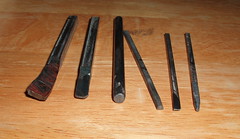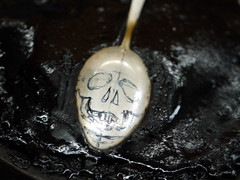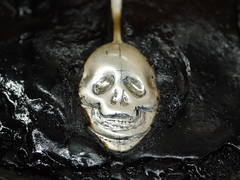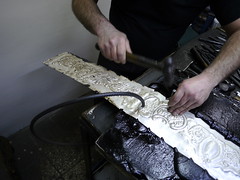Lately I have run across several instances of people having no idea how a technical word should be pronounced. First let’s learn how to say these words correctly. Chasing is said just the way it looks – the dog is chasing the cat. But the second is a french word: repousse is pronounced ray – poo – say.
The process of chasing and repousse almost looks like stamping, until you look closely. When we use stamps on metal, the metal sheet is placed on another hard metal surface and the stamp literally crushes itself down into the surface of the metal sheet. The metal sheet remains mostly flat with only a tiny ridge of metal around the stamped design.
Chasing and Repousse uses tiny stamps, usually in simple shapes, to form the metal.The metal sheet is backed with a flexible substance, and the metal becomes three dimensional.
Here is an example of the sort of simple tools that are used to do chasing and repousse.
So what EXACTLY do these words mean? Repousse is hammering the metal sheet from the back to raise the surface of the metal and chasing is lightly stamping the raised design from the front to add more detail and refine the raised shape.
These techniques were developed a couple of thousand years ago and were most famously used on gold sheet by groups that included the Scythians, Greeks, Romans, Celts and Franks.
Here is an example of what chasing and repousse can look like.This is a 16th century gilt copper piece from Tibet.
How can you hammer on a piece of metal from the back and allow the metal to stretch and become three dimensional? Pitch! Pitch is a flexible substance, which becomes semi-liquid when heated. It is melted and placed into a special heavy metal bowl. The metal is placed into the surface and allowed to stick there. If you place the metal face down in the pitch you can then shape and hammer it from the back to create your design. The pitch bowl is heavy and very stable – so you have both hands free to hold your tools. When the design is completed, the pitch is reheated and the metal is removed and cleaned. The metal can then be flipped over and re-anchored in the pitch for the chasing portion of the work.
Here are two pictures which show the before and after of a chasing project. The black substance in the background is pitch. The artist has taken a simple silver spoon, set it into pitch, drawn the design on the spoon and then used the chasing tools to form the metal.
There is no repousse involved in this project because the artist is using the already domed bowl of the spoon for that part of the project.
Here is another example of chasing without the repousse. The artisan is simply hammering the metal down into pitch the create a low relief design.
It is also possible to do simple chasing and repousse on a sand bag, which is exactly what it sounds like – a leather bag loosely filled with fine sand. This system is less stable and is generally not used for extremely detailed small pieces because of the difficulty of holding the pieces while working on them.
I hope this brief account of the technique of chasing and repousse gives you a better understanding of the complexity of the process and the amount of work involved. It may sound simple, but it really is quite time consuming and requires a LOT of attention to detail.
Next Time: Engraving





